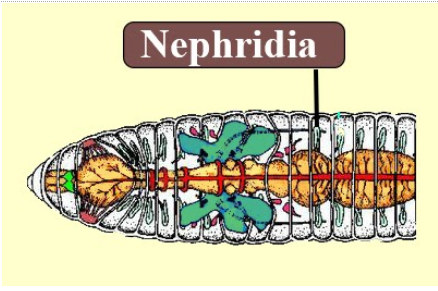
Excretion in most annelids takes place by
(a)Kidneys
(b)Flame cells
(c)Nephridia
(d)Both B and C
Answer
584.7k+ views
Hint: In many invertebrate animals a tubule that usually opens into the body cavity and the other to the exterior, acts as an organ of excretion i.e. used to remove metabolic wastes from an animal's body. This organ usually has ciliated or flagellated cells and absorptive walls.
Complete answer:
The nephridia occur in pairs on each segment on the annelid and are an invertebrate organ present in annelids which function as waste removal from the annelids body. The nephridia pump water carrying toxins from food, ions, and useless hormones out of the organism by directing them down funnel-shaped bodies and then removed out at the nephridiopore. The primary waste or urine produced by filtration of blood is modified into secondary urine through selective reabsorption by the metanephridium lining cells. It is also found in arthropods and Mollusca.
In some annelids, the nephridium tubule does not open into the body cavity but ends internally in a cluster of cells known as solenocytes or flame cells. The characteristics of some annelids that allies them with other non-segmented phyla that have no true body cavity are characterized by the possession of these cells. These kinds of annelids belonging to phyla are primarily aquatic and known ones excrete ammonia.

So, the correct answer is option ‘Nephridia’.
Note: Kidneys are present in humans and are a part of the excretory system. Flatworms have flame cells used as excretory organs which help to excrete metabolic waste by the constant beating of cilia. They are also found in rotifers and nemerteans.
Complete answer:
The nephridia occur in pairs on each segment on the annelid and are an invertebrate organ present in annelids which function as waste removal from the annelids body. The nephridia pump water carrying toxins from food, ions, and useless hormones out of the organism by directing them down funnel-shaped bodies and then removed out at the nephridiopore. The primary waste or urine produced by filtration of blood is modified into secondary urine through selective reabsorption by the metanephridium lining cells. It is also found in arthropods and Mollusca.
In some annelids, the nephridium tubule does not open into the body cavity but ends internally in a cluster of cells known as solenocytes or flame cells. The characteristics of some annelids that allies them with other non-segmented phyla that have no true body cavity are characterized by the possession of these cells. These kinds of annelids belonging to phyla are primarily aquatic and known ones excrete ammonia.

So, the correct answer is option ‘Nephridia’.
Note: Kidneys are present in humans and are a part of the excretory system. Flatworms have flame cells used as excretory organs which help to excrete metabolic waste by the constant beating of cilia. They are also found in rotifers and nemerteans.
Recently Updated Pages
The number of solutions in x in 02pi for which sqrt class 12 maths CBSE

Write any two methods of preparation of phenol Give class 12 chemistry CBSE

Differentiate between action potential and resting class 12 biology CBSE

Two plane mirrors arranged at right angles to each class 12 physics CBSE

Which of the following molecules is are chiral A I class 12 chemistry CBSE

Name different types of neurons and give one function class 12 biology CBSE

Trending doubts
One Metric ton is equal to kg A 10000 B 1000 C 100 class 11 physics CBSE

Explain zero factorial class 11 maths CBSE

What is 1s 2s 2p 3s 3p class 11 chemistry CBSE

Discuss the various forms of bacteria class 11 biology CBSE

State the laws of reflection of light

An example of chemosynthetic bacteria is A E coli B class 11 biology CBSE




